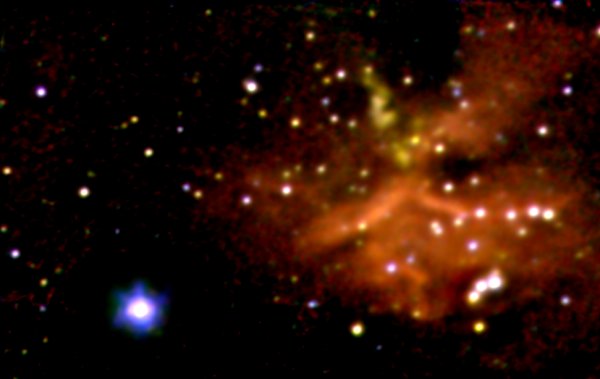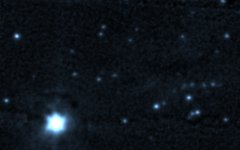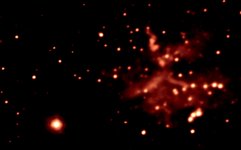Star Forming Region G45.45+0.06
Gemini North Image - June 1999
Color composite infrared image using adaptive optics on the Gemini North telescope.
Dust obscures this star forming region at optical wavelengths but is visible at longer infrared wavelengths.
(Resolution = 0.12 arcseconds FWHM)

Photo Credit: Gemini Observatory, US National Science Foundation, and University of Hawaii Institute for Astronomy |

Gemini North Image at "J", 1.25µm |
The image on the left shows G45.45+0.06 using light with a wavelength slightly longer (redder) than is visible to the human eye. The image on the right was taken using even redder light to reveal the power of infrared radiation for exploring star forming regions. |

Gemini North Image at "K", 2.2µm |
Download a 300dpi JPEG file of the color composite image, the J-band image, or the K-band image.

This infrared image taken with the Gemini North telescope reveals, with unprecedented clarity, a distant
star forming region in our Milky Way galaxy. The longer wavelengths of infrared light allow astronomers
to observe these new stars and explore the processes of star formation.
Most of the stars in this cluster are not seen at visible wavelengths. They are still buried within the large
cloud of dust and gas out of which they formed, and the dust absorbs the visible light from the stars while
some of the redder or infrared light escapes. The reddest objects are likely to be more deeply buried in the
cloud and may still be in the process of accumulating material from the cloud to form a star.
The cluster is designated as G45.45+0.06. The brightest star (at lower left) is in the foreground and is not
part of the cluster.
The diffuse infrared light seen in this image is both starlight reflected off dust particles in the cloud and
glowing hydrogen gas that is heated by the most massive young stars in the cluster. The three bright stars
near the lower right hand corner of the image may be responsible for most of the hydrogen heating and are
about 10 times more massive than our sun and more than 100,000 times brighter. Image analysis,
combined with follow-up spectroscopy, will enable astronomers to determine such things as the ages of the
stars in the cluster, the principal heating sources and what may cause an interstellar cloud collapses to form
new stars.
This image was obtained with the Gemini North telescope on Mauna Kea using the University of Hawaii's
infrared camera, QUIRC, with the Adaptive Optics system called Hokupa'a. Adaptive optics systems use
deformable mirrors to correct for the effects of atmospheric distortions of starlight resulting in significantly
sharper images. The United States National Science Foundation has provided financial support to the
University of Hawai'i Adaptive Optics Program.
Color Composite: "H" band (Blue); "K" band (Green); Narrow band Brgamma filter (Red).
Technical Information for the Observations
Back to the Gemini North Dedication Page



